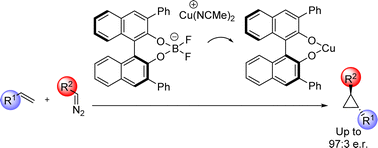Chiral BINOL-based borate counterions: from cautionary tale on anion stability to enantioselective Cu-catalyzed cyclopropanation†
Abstract
The chiral weakly coordinating (3,3′-biphenyl-BINOL)BF2 anion can be generated by the reaction of the BINOL derivative with Cu(NCMe)4BF4. Structural analysis suggest the anion is weakly coordinating to Cu+. However, its use in cyclopropanation reactions leads to the rearrangement of the anion to create a chiral 3,3′-diphenyl-BINOL ligand that coordinates to copper. The latter suggests an important feature to consider when using weakly association anions, but can also be used to design simple chiral BINOL-based ligands for asymmetric cyclopropanation.



 Please wait while we load your content...
Please wait while we load your content...